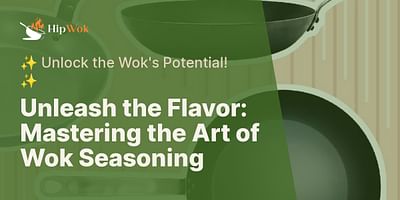Marina Lakin is a professional nutritionist who ardently trusts in the benefits of wholesome, home-prepared meals. She encourages the incorporation of wok in regular cooking as it enables the creation of diverse, nutritious meals in a swift and simple manner.
Great question! Many people wonder why woks aren't pre-seasoned when they purchase them. Seasoning a wok is an essential step that helps create a non-stick surface and enhances the flavor of your dishes. While it may seem like an extra task, trust me, it's worth the effort! Let me explain why woks aren't pre-seasoned and how you can easily season your new wok at home.
Firstly, woks are typically made from carbon steel, which is a durable and excellent conductor of heat. However, carbon steel is prone to rusting if not properly cared for. To prevent rust and ensure the longevity of your wok, it's crucial to season it before use.
Secondly, the seasoning process involves creating a natural non-stick coating on the surface of the wok. This coating is formed by heating oil in the wok until it polymerizes, creating a layer that prevents food from sticking. While some manufacturers may apply a factory seasoning, it's often not enough to provide the desired non-stick properties.
Additionally, pre-seasoning a wok in a factory can be challenging because each person's cooking preferences and techniques vary. By leaving the seasoning process to the user, it allows for a more customized experience. You have the freedom to choose the type of oil and seasoning ingredients that suit your cooking style and taste preferences.
Now, let's dive into the process of seasoning your new wok. It's a straightforward and rewarding task that will ensure your wok performs at its best.
1. Wash your wok: Before seasoning, wash your wok with warm water and a mild detergent to remove any factory residue. Rinse it thoroughly and dry it completely.
2. Heat your wok: Place your wok on the stove over medium-high heat. Allow it to heat up for a few minutes until it starts to smoke. This step helps open up the pores of the metal, allowing the oil to penetrate and create a non-stick surface.
3. Add oil: Once your wok is hot, add a high-smoke-point oil like vegetable, canola, or peanut oil. Swirl the oil around, ensuring it coats the entire surface of the wok, including the sides. You can use a paper towel or a heat-resistant brush to spread the oil evenly.
4. Heat and cool: Continue heating the wok with the oil for about 10-15 minutes. You may notice the wok changing color, which is a good sign that the seasoning process is taking place. Afterward, turn off the heat and allow the wok to cool down completely.
5. Wipe off excess oil: Once the wok has cooled, use a paper towel or a clean cloth to wipe off any excess oil. Your wok is now seasoned and ready to use!
Remember, seasoning is an ongoing process. The more you cook with your wok, the better the seasoning will become. Each time you use it, a thin layer of oil will continue to build up, enhancing its non-stick properties and adding flavor to your dishes.
In conclusion, woks aren't pre-seasoned from the factory to ensure that you have the freedom to customize the seasoning process according to your preferences. By seasoning your wok at home, you create a non-stick surface and protect it from rusting. So, embrace the seasoning process, and get ready to enjoy the delicious flavors that a well-seasoned wok can bring to your Asian-inspired dishes!















